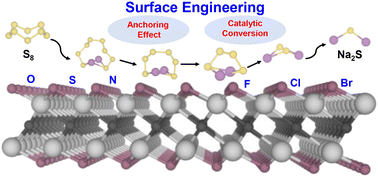Covalent surface modification of bifunctional two-dimensional metal carbide MXenes as sulfur hosts for sodium–sulfur batteries†
Abstract
Room temperature sodium–sulfur (RT Na–S) batteries show extraordinary potential in large-scale energy storage. MXenes have been demonstrated to be promising sulfur hosts for Na–S batteries, and their surface functional groups play a pivotal role in their performance. However, the effect of different surface functional groups of MXenes on their anchoring effect and catalytic performance has not been systematically investigated. Herein, density functional theory (DFT) calculations were employed to explore the various electrochemical performances of a series of Ti2CTx (T = O, S, N, F, Cl, and Br) MXenes as sulfur hosts for Na–S batteries. We find that surface functional groups significantly affect the structural properties of MXenes as well as their electrochemical performance. Ti2CO2, Ti2CS2, and Ti2CN2 exhibit prominent affinity toward soluble sodium polysulfides. Moreover, they display excellent catalytic activity toward the sulfur reduction reaction and the decomposition reaction of Na2S. Finally, during the whole discharge process, Ti2CO2, Ti2CS2, and Ti2CN2 always maintain their metallic conductivity, which could improve the rate capability of Na–S batteries. Overall, Ti2CO2, Ti2CS2, and Ti2CN2 are proposed as promising bifunctional sulfur hosts for Na–S batteries, and our results may also provide insights for modulating the performance of MXenes in other applications.



 Please wait while we load your content...
Please wait while we load your content...